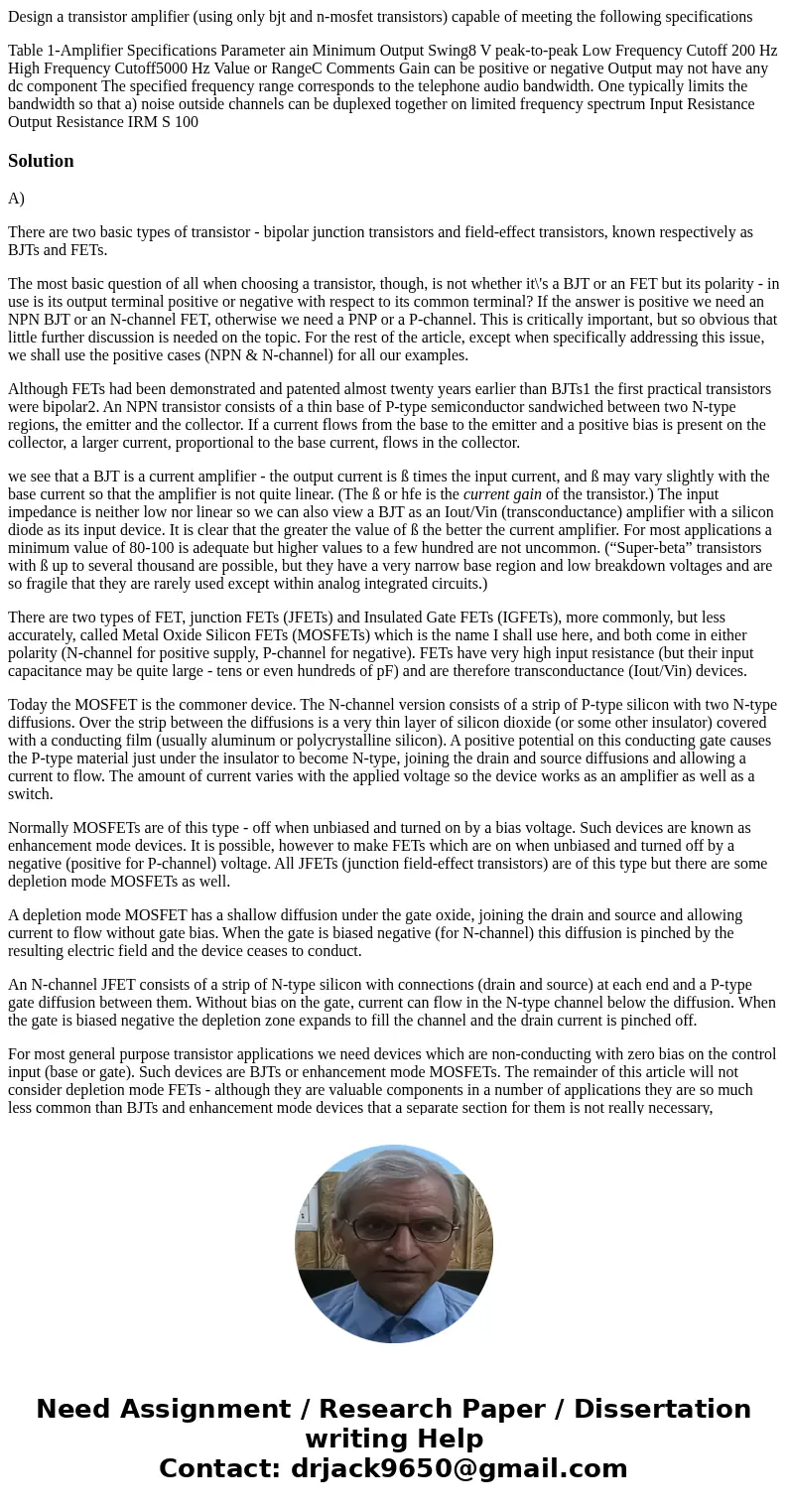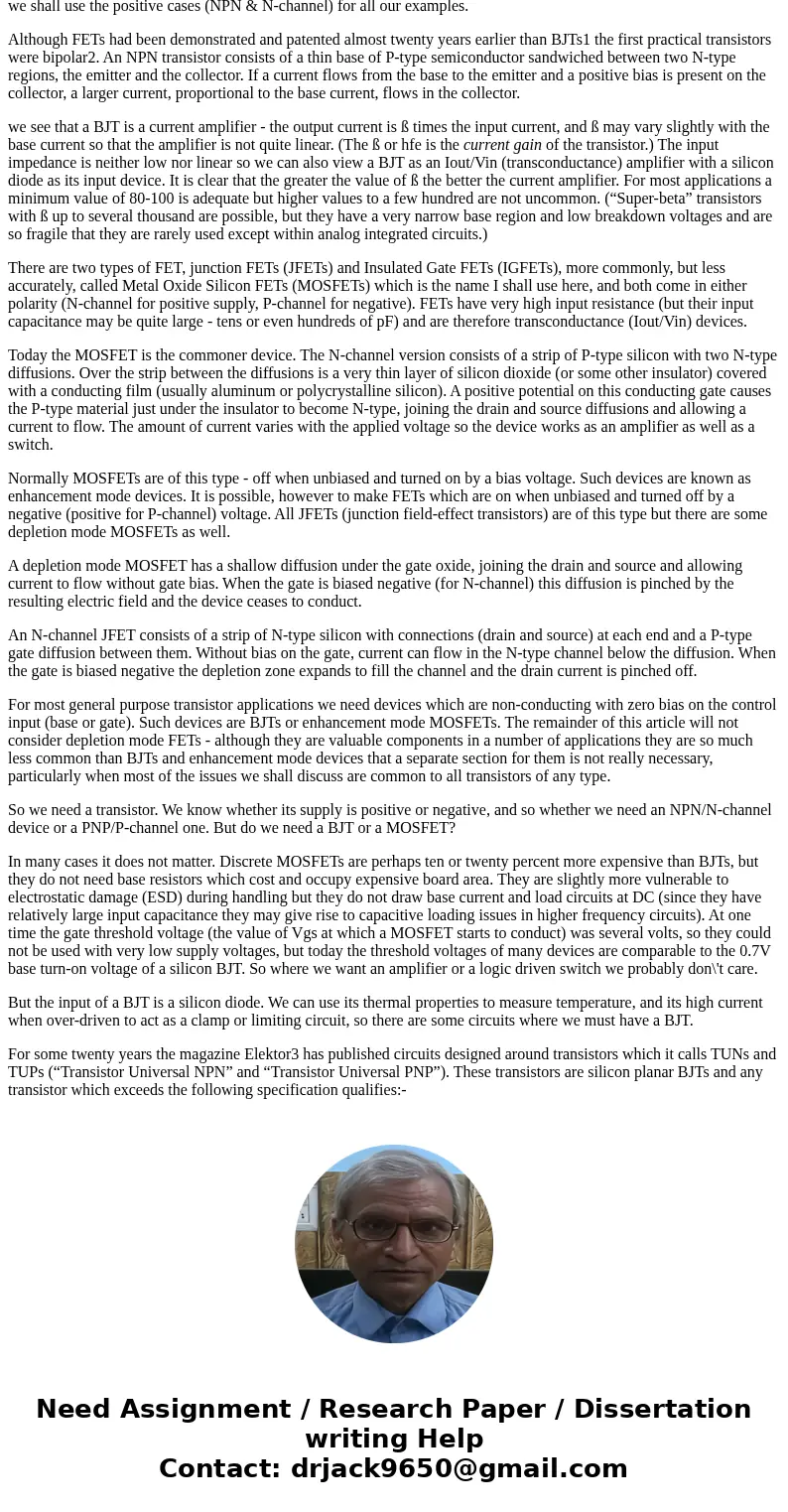Design a transistor amplifier using only bjt and nmosfet tra
Design a transistor amplifier (using only bjt and n-mosfet transistors) capable of meeting the following specifications
Table 1-Amplifier Specifications Parameter ain Minimum Output Swing8 V peak-to-peak Low Frequency Cutoff 200 Hz High Frequency Cutoff5000 Hz Value or RangeC Comments Gain can be positive or negative Output may not have any dc component The specified frequency range corresponds to the telephone audio bandwidth. One typically limits the bandwidth so that a) noise outside channels can be duplexed together on limited frequency spectrum Input Resistance Output Resistance IRM S 100Solution
A)
There are two basic types of transistor - bipolar junction transistors and field-effect transistors, known respectively as BJTs and FETs.
The most basic question of all when choosing a transistor, though, is not whether it\'s a BJT or an FET but its polarity - in use is its output terminal positive or negative with respect to its common terminal? If the answer is positive we need an NPN BJT or an N-channel FET, otherwise we need a PNP or a P-channel. This is critically important, but so obvious that little further discussion is needed on the topic. For the rest of the article, except when specifically addressing this issue, we shall use the positive cases (NPN & N-channel) for all our examples.
Although FETs had been demonstrated and patented almost twenty years earlier than BJTs1 the first practical transistors were bipolar2. An NPN transistor consists of a thin base of P-type semiconductor sandwiched between two N-type regions, the emitter and the collector. If a current flows from the base to the emitter and a positive bias is present on the collector, a larger current, proportional to the base current, flows in the collector.
we see that a BJT is a current amplifier - the output current is ß times the input current, and ß may vary slightly with the base current so that the amplifier is not quite linear. (The ß or hfe is the current gain of the transistor.) The input impedance is neither low nor linear so we can also view a BJT as an Iout/Vin (transconductance) amplifier with a silicon diode as its input device. It is clear that the greater the value of ß the better the current amplifier. For most applications a minimum value of 80-100 is adequate but higher values to a few hundred are not uncommon. (“Super-beta” transistors with ß up to several thousand are possible, but they have a very narrow base region and low breakdown voltages and are so fragile that they are rarely used except within analog integrated circuits.)
There are two types of FET, junction FETs (JFETs) and Insulated Gate FETs (IGFETs), more commonly, but less accurately, called Metal Oxide Silicon FETs (MOSFETs) which is the name I shall use here, and both come in either polarity (N-channel for positive supply, P-channel for negative). FETs have very high input resistance (but their input capacitance may be quite large - tens or even hundreds of pF) and are therefore transconductance (Iout/Vin) devices.
Today the MOSFET is the commoner device. The N-channel version consists of a strip of P-type silicon with two N-type diffusions. Over the strip between the diffusions is a very thin layer of silicon dioxide (or some other insulator) covered with a conducting film (usually aluminum or polycrystalline silicon). A positive potential on this conducting gate causes the P-type material just under the insulator to become N-type, joining the drain and source diffusions and allowing a current to flow. The amount of current varies with the applied voltage so the device works as an amplifier as well as a switch.
Normally MOSFETs are of this type - off when unbiased and turned on by a bias voltage. Such devices are known as enhancement mode devices. It is possible, however to make FETs which are on when unbiased and turned off by a negative (positive for P-channel) voltage. All JFETs (junction field-effect transistors) are of this type but there are some depletion mode MOSFETs as well.
A depletion mode MOSFET has a shallow diffusion under the gate oxide, joining the drain and source and allowing current to flow without gate bias. When the gate is biased negative (for N-channel) this diffusion is pinched by the resulting electric field and the device ceases to conduct.
An N-channel JFET consists of a strip of N-type silicon with connections (drain and source) at each end and a P-type gate diffusion between them. Without bias on the gate, current can flow in the N-type channel below the diffusion. When the gate is biased negative the depletion zone expands to fill the channel and the drain current is pinched off.
For most general purpose transistor applications we need devices which are non-conducting with zero bias on the control input (base or gate). Such devices are BJTs or enhancement mode MOSFETs. The remainder of this article will not consider depletion mode FETs - although they are valuable components in a number of applications they are so much less common than BJTs and enhancement mode devices that a separate section for them is not really necessary, particularly when most of the issues we shall discuss are common to all transistors of any type.
So we need a transistor. We know whether its supply is positive or negative, and so whether we need an NPN/N-channel device or a PNP/P-channel one. But do we need a BJT or a MOSFET?
In many cases it does not matter. Discrete MOSFETs are perhaps ten or twenty percent more expensive than BJTs, but they do not need base resistors which cost and occupy expensive board area. They are slightly more vulnerable to electrostatic damage (ESD) during handling but they do not draw base current and load circuits at DC (since they have relatively large input capacitance they may give rise to capacitive loading issues in higher frequency circuits). At one time the gate threshold voltage (the value of Vgs at which a MOSFET starts to conduct) was several volts, so they could not be used with very low supply voltages, but today the threshold voltages of many devices are comparable to the 0.7V base turn-on voltage of a silicon BJT. So where we want an amplifier or a logic driven switch we probably don\'t care.
But the input of a BJT is a silicon diode. We can use its thermal properties to measure temperature, and its high current when over-driven to act as a clamp or limiting circuit, so there are some circuits where we must have a BJT.
For some twenty years the magazine Elektor3 has published circuits designed around transistors which it calls TUNs and TUPs (“Transistor Universal NPN” and “Transistor Universal PNP”). These transistors are silicon planar BJTs and any transistor which exceeds the following specification qualifies:-


 Homework Sourse
Homework Sourse